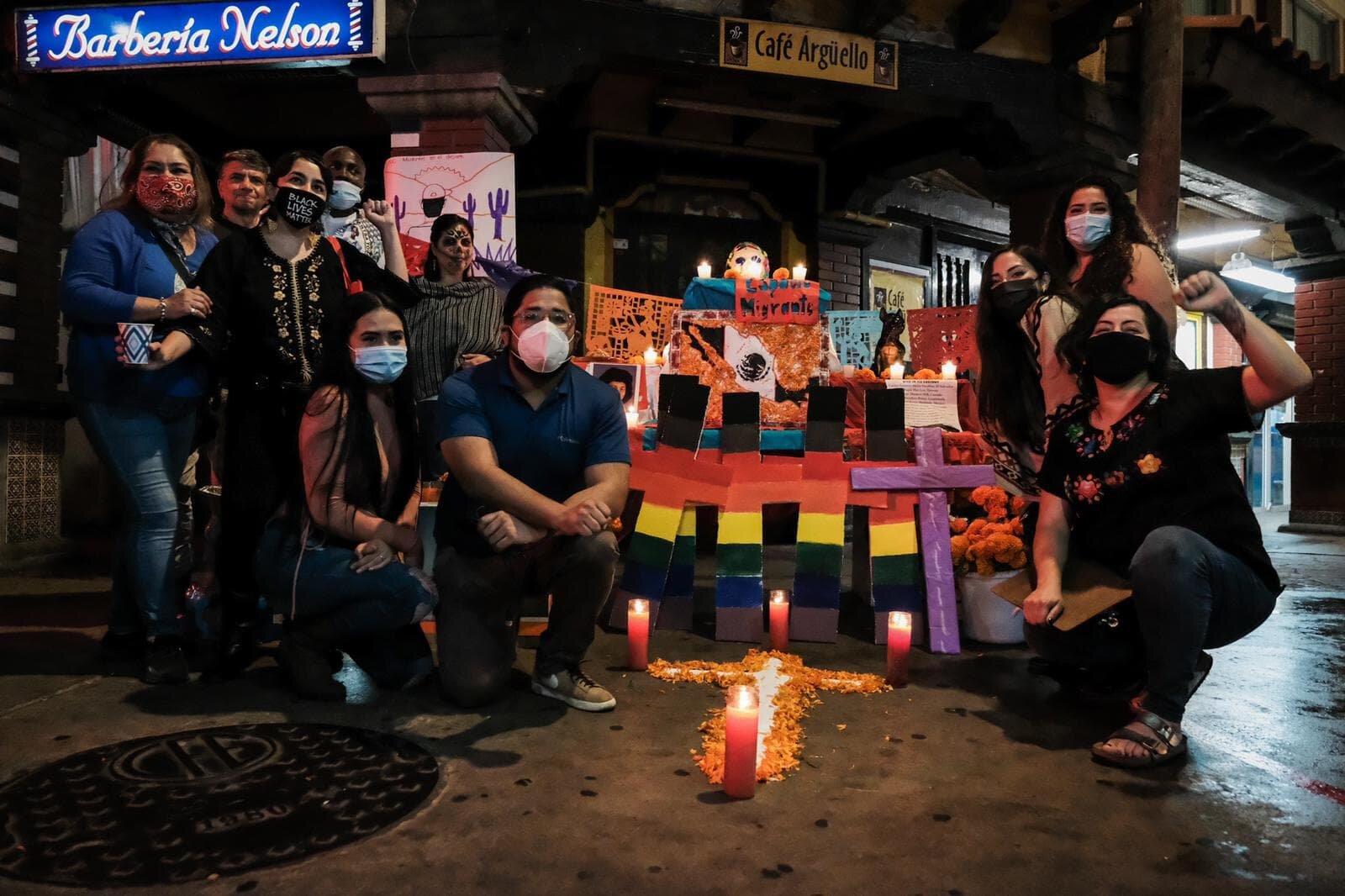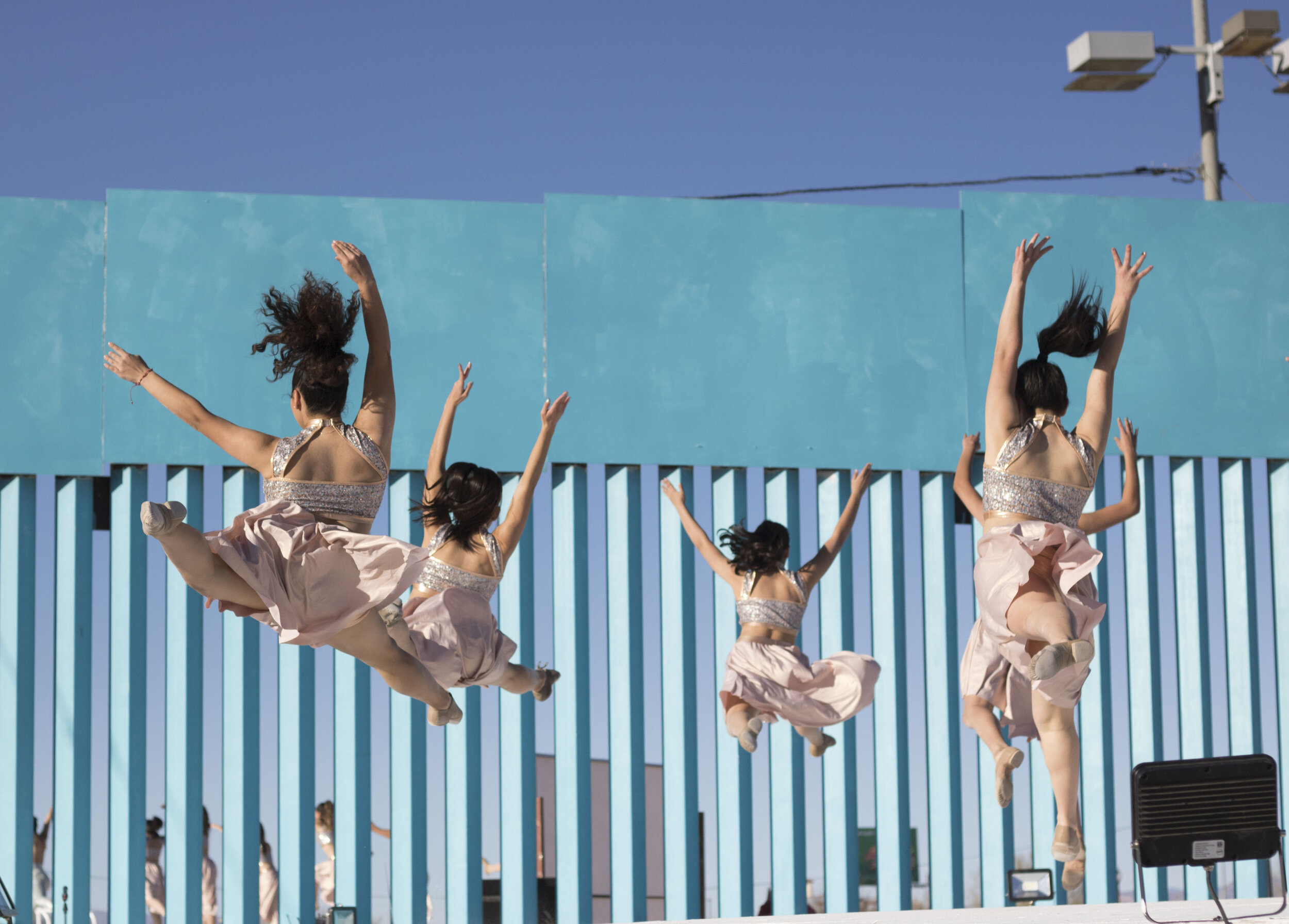“Dignity, Resilience and Beauty.” Funding Initiative Seeks to Reclaim Border Narratives
/The Espacio Migrante team and volunteers engage in a traditional cultural practice during an action that embodies “Resiste Gozando,” which means Resisting with Joy. The San Ysidro, California-based group is a 2020 NALAC Border Narrative Change Grantee. Photocredit: Jeff Valenzuela
The U.S.-Mexico border has become an increasingly controversial topic in recent years. From the Trump administration’s high-profile attempts to erect a wall between the two countries, to the practice of separating families and placing children in detention centers, the prevailing narratives about what happens at the border are often grim and contentious.
For some, the border is synonymous with crime, danger and drug trafficking. And although immigration to the U.S. from the southern border has declined in recent years (with the exception of a surge in migrant children), the border is often portrayed as the site of an invasion. The negative language often used in border narratives, along with the continued portrayal of immigrants as a nameless, faceless horde that threatens the U.S. and its citizens, has dehumanized migrants and the people who live along the border.
A new initiative is looking to change that narrative.
The Ford Foundation is partnering with four organizations—Borealis Philanthropy, the Center for Cultural Power, the National Association of Hispanic Journalists (NAHJ) and the National Association of Latino Arts and Cultures (NALAC)—to launch a three-year, $4.5 million initiative called Reclaiming the Border Narrative.
The project’s aim is to reshape the national conversation about the border by enabling “impacted communities to share authentic narratives about the border.”
According to the Ford Foundation, “funding will enable immigrant rights advocates, artists, writers and organizations to work over the next three years to organize and preserve stories reflecting the dignity and truth of border communities, connecting and empowering them to center their own narrative on their terms and in their voices.”
In addition to Ford’s overall focus on fighting inequality, the new initiative aligns with three of the foundation’s programs—the Gender, Racial, and Ethnic Justice program, the Creativity and Free Expression program, and the Cities and States program. Last year, Ford announced that it would double its racial justice and civil rights grantmaking, bringing planned funding in this arena to $330 million through 2021. And a recent, significant commitment in support of Black, Latino, Asian and Indigenous arts organizations suggests that cultural work is central to Ford’s vision of racial justice.
“It’s clear that culture and stories shape national policies about immigration,” said Favianna Rodriguez, cultural strategist and president of the Center for Cultural Power. “For too long, our country’s dominant story has been one of criminalization and dehumanization, which has led to children and families being held in cages.”
“We know that art and culture is our most powerful conduit for transformative change,” added María López de León, president and CEO of NALAC. “Using their artistic and cultural practice strategically to advance justice, artists and culture makers along the southern border will create works which reflect the dignity, resilience and beauty that is inherent in border communities and our histories.”
How it works
The Ford Foundation has made grants to the four partner organizations, which in turn have regranted the money to 43 organizations and individuals living along the border in California, Arizona, New Mexico and Texas. The first round of grants have already been made, and an additional five artists and organizations will also be receiving grants in the near future.
Some of the grantees include the Asylum Seeker Advocacy Project, the Haitian Bridge Alliance, Sueños Sin Fronteras de Tejas (Dreams Without Borders From Texas), the Borderlands Theater, and the Workers Defense Project.
The Ford Foundation will also provide training and technical assistance to the grantees in order to help them “improve and expand their capacity to use documentation, storytelling, and other forms of creative expression to advance their organizing and advocacy agenda beyond the life of their grants.”
Notably, the Reclaiming the Border Narrative project will also provide an archive for its work. The Southwest Folklife Alliance will document the work generated by the project and compile it into a digital archive to “collect, house and preserve the stories from the border, and include contributions of other communities, advocates and creatives after the project ends.”
So why do negative narratives about the border matter? And why is this something Ford is prioritizing?
“Negative narratives about people of color have been used historically to really drive inequality,” said Margaret Morton, director for the Ford Foundation’s Creativity and Free Expression program.
“We knew that we didn’t have all the answers,” she added, “but we wanted to help in a constructive way.... We wanted to come together and find a way to actively work together and to use our tools in philanthropy to actually lift up, to correct, to change what we knew to be untrue and very racist narratives.”
Dancers perform a piece by Ana Maria Alvarez entitled “Shared Spaces | Espacios Compartidos.” The performance was produced by Douglas, Arizona-based Border Arts Corridor, a 2020 NALAC Border Narrative Change Grantee, Photo credit: Ammi Robles
The political power of narratives
Despite the fact that the U.S. population is mostly made up of immigrants and people who descended from immigrants, prevailing narratives around immigration are often negative.
Anti-immigrant media outlets, organizations and individuals have propagated damaging narratives about the border. President Donald Trump, for example, made anti-immigrant rhetoric a cornerstone of his political career, from his presidential campaign announcement, when he referred to Mexican immigrants as drug traffickers and rapists, to his barrage of policies designed to prevent immigration. Building a wall along the border and increasing border security sends the message that the border is a dangerous place.
“We’ve really seen these negative narratives about the border being out of control, the border needing to be brought under control, as really incredibly damaging, in particular to border communities, of course, but also nationally; migrants everywhere kind of suffer the repercussions of these negative border narratives,” said Mayra Peters-Quintero, senior program officer for Ford Foundation’s Gender, Racial, and Ethnic Justice program.
But these stories are not new. They both precede the Trump administration and have prevailed even after the end of his presidency. Crucially, they send a message that migration as a whole, not just illegal migration, is a dangerous threat, which in turn has led to increased spending on border security.
A recent report by the American Immigration Council found that since 1993, the U.S. Border Patrol’s budget has increased 10-fold, from about $363 million to almost $4.9 billion. ICE spending has gone from $3.3 billion in 2003 to $8.3 billion, with much of the funding going to immigrant detention.
Peters-Quintero added, “For some leaders and elected officials, they have seen political gain, so leaning into an anti-immigrant message, even when the person doesn’t hold those values deeply, has resulted in increased support from certain sectors and political gains.”
Peters-Quintero also explained how these false narratives around the border have affected policy decisions. “If you have a narrative around fear and scarcity and invasion and people crawling over the border to take what belongs to Americans—jobs, culture, prosperity—if you have that narrative, the policy that flows from that naturally is policy that tightens and closes and seals the border and ensures that that kind of invasion doesn’t happen.” Conversely, if that narrative is one of abundance, diversity and community, the policy that naturally follows will not be one of closure and punishment.
One of the biggest issues, Peters-Quintero pointed out, is that decisions about immigration policies are made far from the border itself. “The voice and images and the experience of the border does not often penetrate the conversations in Washington, D.C., where the policy and appropriations decisions are made,” said Peters-Quintero. “So people have leaned into that disconnect to their advantage and have really politicized an issue for what we would consider problematic aims that don’t put the wellbeing and the health of border communities first.”
Reclaiming the Border Narrative seeks to close that knowledge gap through supporting first-hand, authentic stories from the border. The twin elephants in the room that need to be countered are, of course, racism and xenophobia.
“Racism is a part of it,” said de Leon, “and it’s a horrible thing to see children in cages, to see people in cages, to see children separated from their parents.” While the images and stories of caged children drew widespread criticism, it still wasn’t enough to create significant change.
“That just didn’t seem to move the hearts of those people in power,” said de Leon, “and so we just believe that it’s the immigrant rights activists, the artists, the writers, the organizations that will really bring up and elevate the stories that reflect the dignity of the communities we serve.”
A painting by immigrant artist Yevgenia Golik, as prototype for a mural to be painted by students and community in a diverse neighborhood. image provided by san diego-based New Americans Museum, a 2020 NALAC Border Narrative Change Grantee. artistic credit: Y. Golik for NAM.
A new strategy for change
NALAC, which has been making grants for almost 16 years and awarded 27 of the Reclaiming the Border Narrative project’s grantees, has long supported Latino artists and arts and cultural organizations. To choose its grantees, NALAC invited artists and organizations for virtual cafecitos, or coffees.
“When we convened the virtual cafecitos, we asked people to really talk about some of the words that they hear or that we hear in our communities about immigration and about migrants coming to this country,” said de Leon.
The most common words mentioned were “militarized,” “dangerous,” “surveillance,” “scary” and “drugs.” However, when asked about the communities’ perspectives about the border, the language changed dramatically.
“It was words that went from ‘militarized’ and ‘dangerous’ to ‘solidarity,’ to ‘resilience,’ ‘community,’ ‘strong,’ ‘home,’ ‘healing,’ ‘culture,’ ‘intercultural,’” said de Leon. “It’s imperative to shift that narrative to one of positivity, of potential, of opportunity.”
According to Peters-Quintero, grantees who work on the advocacy and policy front “have been moving increasingly toward using cultural strategies and incorporating storytelling and art... instead of just straight advocacy or straight organizing.”
The Reclaiming the Border Narrative project has also taken care to shed light on a broad range of experiences, including those of LGBTQ migrants, Afro-Latino migrants and migrants with disabilities.
Grantmakers also highlighted that the grantees will be the driving force behind the work. “We really want affected communities and people who are having this lived experience in the driver’s seat,” said Peters-Quintero.
“We are not trying to dictate and prescribe exactly what this work should look like and what it will result in,” she added. “We’re doing our best to support the field and what they produce, and center affected communities, because we think the people closest to the problems have the best solutions and the best ideas.”
While changing immigration policy will require more than rewriting the narrative around the border, grantmakers hope it will provide a step in the right direction.
“Narrative work is very important to us, and it’s one approach and one that we’re dedicated to following because it is so critically important,” said Morton.
“We’ve also looked at how narratives have impacted people of color to basically justify discrimination historically,” Morton added. “And we thought we would step back, work together collaboratively and find a way to work together on our immigration reform front, on our creative front, and on our activism front to help kind of change those narratives and bring out the truth about what was really a humanitarian problem, underneath this very complicated immigration system.”











